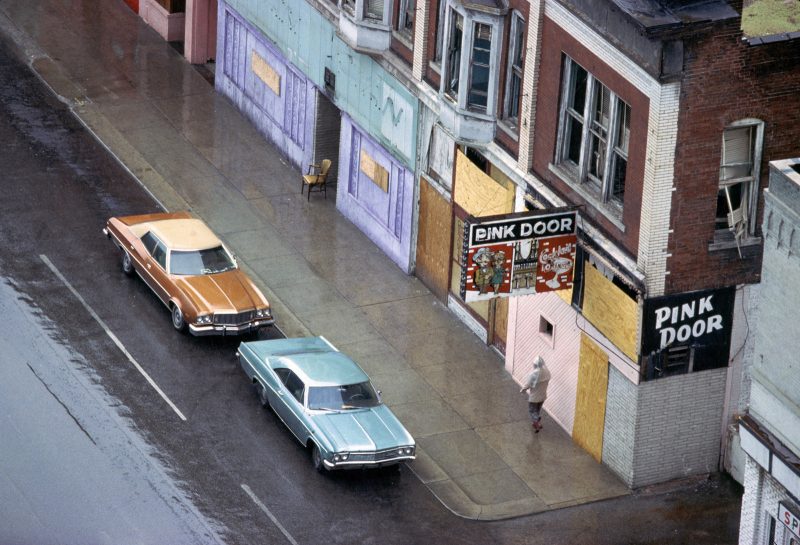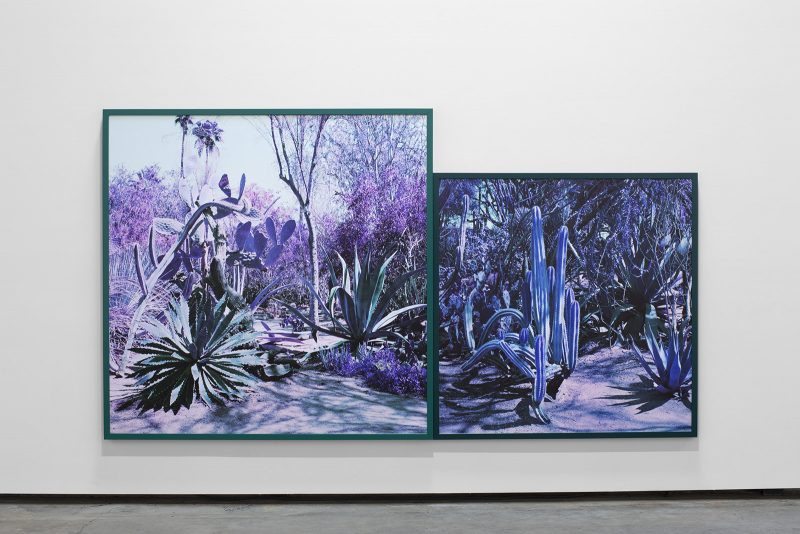Vancouver, once a far west outpost on the edge of North America, has become one of the most ethnically diverse cities anywhere with a backdrop of snow peaked mountains, clean rivers and bays. And it is thriving, thanks in part to a cultural openness, liberal immigration laws, vibrant film, tech, mining and forestry industries, and one of the world’s largest ports – the North American gateway the Pacific Rim. The city’s art community has benefited from the economic and cultural growth and extends from The Flats to the South Granville district, with galleries, museums and art centers scattered throughout the rest of this sprawling city. Here’s a look at two galleries in The Flats that I visited this summer.
Equinox highlights photos by Fred Herzog, age 87
In a summer group show of Equinox gallery artists a wall of 10 prints by Fred Herzog shows a lost Vancouver bathed in cadmium reds, powder blues and sun-bleached cement sidewalks.
Herzog’s 50-year romance with Kodachrome is a love song to the streets and the storefronts of Vancouver, British Columbia. The 87-year old, German-born artist has photographed the neighborhoods of his adopted city since the 1950s almost exclusively with Kodachrome slide film. With vibrant cadmium reds, and rich royal and sky blues, canary yellows and glowing neon signage, Herzog’s Vancouver at once immortalizes the Pacific Northwest city and offers up a study in architecture, sociology, color and composition.
Because of the prohibitive costs of color printing, Herzog had always projected his photographs onto walls – whatever walls were available. Though he was known by many local Vancouver artists, among them photographer Roy Arden, Herzog’s reputation remained underground. But 10 years ago Herzog along with his gallery, Equinox, produced and printed a full retrospective of his photos, making them visible to a wider public. Herzog’s Vancouver – its streets, people and storefronts came alive in his images and seduced not just Vancouver’s art world, but aligned the photographer with several generations of artists.
Shown simultaneously at Equinox and The Vancouver Art Gallery, Herzog’s color-drunk photographs from the 1950s and 1960s brought into focus another artist working along the lines of Harry Callahan, William Eggleston and Stephen Shore. These storefronts and tightly-cropped street scenes recall a growing color-drenched urban world once found weekly in LIFE magazine spreads of the same era.

A 1967 photograph, “Family,” offers up a window shopping moment with mother in white gloves and paisley dress tilting a lit cigarette at us while her boys and husband are absorbed by the boutique’s showcase.
In fact windows, with all their advertising signage, are key to Herzog’s aesthetic regard. Words abound in his (now) retro vision of Vancouver. An immigrant from Germany to Canada in 1952, Herzog almost immediately took to the streets to discover and possibly learn English from the neon and printed sales and product signs that covered the main streets. His “Foot of Main” (1968) is a study in space and emptiness, featuring the Army Navy surplus sign painted on a large brick wall, as a couple edges down Main Street.
Herzog makes words and design a subject and object, an underlying subtext and overt subtitle; in other works, he’ll compose the work around storefront architecture and wait for his subject to move into position. It could be two white cars appearing to converse on a darkened twi-lit street, or a man passing through a rectangle of light, framed by a corner grocery store façade, or old photographs of hair cut models in a barbershop.
Herzog’s photographs document an era that most in Vancouver today never knew. Today, as skyscrapers climb upwards on this Pacific Northwest gaggle of islands, and real estate prices race towards the millions of dollars, Herzog’s world, like the one he left in Stuttgart at age 22 has been lost to progress and time.
The Finning Tractor Paint Building & The Flats
But the world of the 1960s is not lost on Vancouver’s contemporary art world. Equinox gallery, along with the Monte Clark Gallery share the 20,000 sq. ft. former Finning Tractor paint shop dating to 1964, a historical landmark for the Flats district of Vancouver. (Finning is the world’s largest distributor of Caterpillar tractors and other earth moving equipment.)
Equinox, which formerly operated a space on Granville Street for some 25 years joined up with The Monte Clark Gallery to take over the historic Finning Tractor paint shop. With ceilings that soar and open spaces that invite massive installations, enormous paintings and group shows that resemble museum collections, these two galleries literally cover the waterfront. The two galleries now serve as an anchor to a growing art community and gallery scene that has attracted other spaces like Winsor, Catriona Jefferies, Macaulay & Company as well as the non-profit art space Grunt, and the art school Emily Carr University.
The summer’s group shows at both galleries currently have the look and feel of a museum exhibitions. Soaring ceilings and airy viewing areas afford dealers Monte Clark and Andy Sylvester of Equinox the luxury of full-on retrospectives of their artists as well as intimate and private views of works (in other spaces carved out for private viewings).
Monte Clark’s group show

Karin Bubaš took up the main galleries in Monte Clark’s space with her “Hidden Valley” large-format landscape photographs of cacti and desert images all shot in California in 2016 and 2017. She is smitten with the sunset hues the dry air serves up, and her palette is soaked in psychedelic pinks and greens.
Gallery artist Roy Arden’s urban landscape photos and collages, and Jeremy Hof’s layered, painted and stripped down objects are spread throughout Clark’s immense exhibition space. Young Brit Paul Housley’s, small painted canvases echo the blunt and blurry portraits of Georges Rouault. Housley’s take on painting is to go small and moody with an art brut sensibility.
Danger in Progress
As the city expands, progress is taking prisoners: A new Sky Train city transport stop is slated to begin construction in the Flats; current plans are to begin demolition of the Finning Tractor building as early as 2019 to make way for a tunnel. The drive by city planners to expand and convert the Flats to a sea of condos and city shops threatens the galleries. Monte Clark, director of the Monte Clark Gallery, said meetings are urgently being set up to preserve the building, the art spaces, and the still-growing arts community in the Flats. Fred Herzog, no doubt, has seen this slide show before.
Summer Exhibitions, Equinox Gallery, Vancouver, BC, June 20, 2017 – September 2, 2017 http://www.equinoxgallery.com/exhibitions/
Karin Bubas Hidden Valley to Aug 5. Monte Clark Gallery, Vancouver, BC, to Aug. 5 http://www.monteclarkgallery.com/










